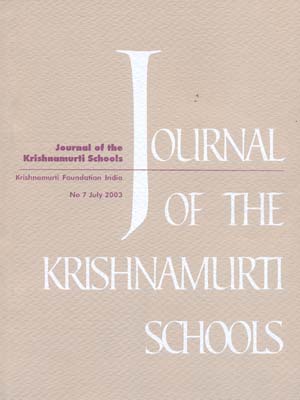Issue 7 - July 2003

- Written by J. Krishnamurti
To look at a flower or a marvellous cloud, you must have a clear, unspotted eye, an eye that has lived and seen a thousand experiences and yet is free of all experience; it is only then that you can see.
- Written by Jayashree Nambiar
Is it possible for a human being to have a sense of goodness in daily life, a goodness that is not idealistic, not sentimental, but actual?
- Written by Patrick Foster
The oldest kind of philosophy, metaphysics, has more often than not consisted of fantastic opinions about the nature of reality.
- Written by O. R. Rao
All the achievements of the great painters, poets and composers are the activity of thought: the composer, inwardly hearing the marvellous sound, commits it onto paper.
- Written by Siddharth Menon
In 1921 when Einstein first visited America, he encountered Edison through a questionnaire.
- Written by Toon Zweers
The students enter the classroom. I watch as they place their history folders on the table around which we all sit.
- Written by Kabir Jaithirtha
In this article I would like to explore the possible ways in which the potentialinherent in geography as a subject can be unfolded, for the teacher and the student.
- Written by Radhika Herzberger
(In this article—based on an introductory talk for a workshop on the teaching of the Humanities held at Rishi Valley School— Radhika Herzberger attempts to elucidate the philosophical positions of Krishnamurti that have a direct bearing on how we construe our past, how we might engage with current issues in history teaching, and how we might respond to the challenge of living a life amidst the currents of social as well as inner divisiveness.
- Written by Jayashree Nambiar
This article describes an attempt to place the student at the centre of the process of learning history.
Read more ...
- Written by Editors
For this year’s annual conference for teachers of Krishnamurti Schools— held at Rajghat Besant School, Varanasi —the theme chosen was Creativity and Insight.
- Written by Shailesh Shirali
This article is an exploration of creativity as well as the more elusive notion of insight.
- Written by Neerja Ragahvan
As the sun sets on a three-day conference centred around the theme of Creativity and Insight, I watch the lengthening shadows and hear the twitter of the birds at dusk.
- Written by K. Subramanian and Rajesh Santhanam
On the Theme and Process of the Project ‘Energy’—the term has many meanings and each of these impacts our lives in direct ways.
- Written by P. Sangeetha
Among high school students in India one finds an extraordinary apathy towards History, a position which the subject shares along with other so-called ‘arts’ subjects.
- Written by V. Geetha
This article tries to point out some of the difficulties faced by a teacher teaching the history of the Indian National Movement to a class of senior students within the constraints of a certain received version of it assumed and propagated by the syllabus and by standard textbooks.
- Written by Sejal Wasani
I must begin by setting the scene. I moved to Chennai, India just under eighteen months ago from the United Kingdom, where I have spent most of my life.
- Written by S. Gopalan
The primary objective and intent of our schools is to awaken intelligence in the educator and the student.
- Written by V. Arun and Sumitra M. Gautama
Just a few days before our last school trip, a friend of ours, an anthropology scholar, visited us at school.
- Written by Adrian Sydenham
As teachers in the K schools we are more than usually concerned with human nature and human consciousness, the very stuff of academic psychology.
- Written by Aarti Kawlra
As parents of children at the school, three of us (Aarti Kawlra, Deepa Kamath and Kalpana Shah Korwar) have been associated with different projects and activities at The School, KFI—in the preparation of a class newspaper, in teaching a session on the role of cotton and weaving in the Industrial Revolution, in the designing of the wash area outside the dining hall.
- Written by Shiv Gaur
I got involved in Origami a couple of years back when I came across a marvelous model of a hyperbolic parabola.
- Written by P. Ramesh
There was a child went forth every day, And the first object he look’d upon and received with wonder or pity or love or dread, that object he became, And that object became part of him for the day or a certain part of the day ...Or for many years or stretching cycles of years.

